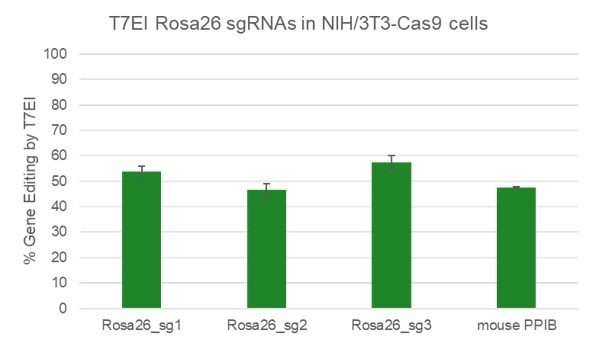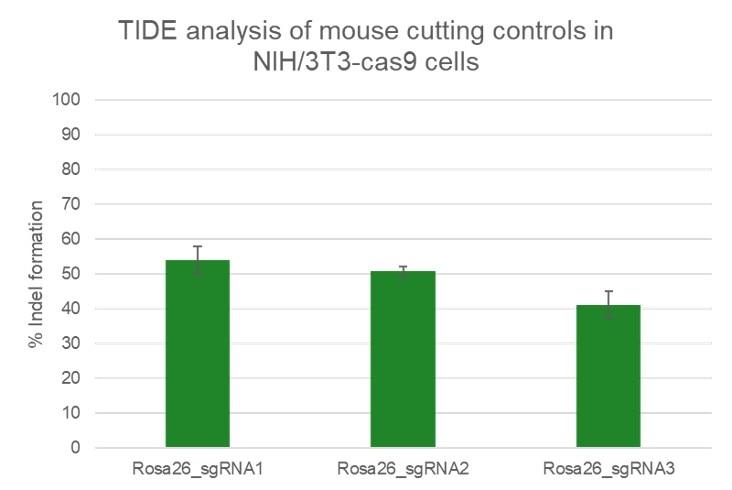- Gene editing
- Gene editing reagents
- Edit-R synthetic sgRNA negative controls
Edit-R synthetic sgRNA negative controls
Bioinformatically designed to not target any gene in the human or mouse genomes.

AAVS1 and Rosa26 cutting controls are designed to target regions of the genome that do not result in functional knockout of a protein or known phenotypic changes. These regions are sometimes known as safe harbor regions. These guides are validated for mismatch detection assays and are recommended for screening applications as an additional control that results in Cas9 cutting without a phenotypic readout.
Non-targeting controls are recommended as negative controls for experiments using synthetic sgRNA. All Edit-R non-targeting controls are designed to have a minimum of three mismatches or gaps to all potential PAM-adjacent targets in the human or mouse genomes. Changes in viability or gene expression levels in cells treated with these controls likely reflect a baseline cellular response that can be compared to the levels in cells treated with target-specific sgRNAs.
Edit-R CRISPR-Cas9 Gene Engineering Platform
The Dharmacon Edit-R Gene Engineering platform is powered by a proprietary algorithm and based on the Type II CRISPR-Cas9 system from the bacteria Streptococcus pyogenes.
- Ready-to-Use Components: The system eliminates the need for cloning, allowing researchers to quickly initiate experiments with predesigned guide RNAs and other essential components, significantly reducing the time to results.
- High Specificity and Efficiency: Edit-R utilizes a proprietary algorithm to design guide RNAs that improve the likelihood of achieving functional knockouts while minimizing off-target effects, ensuring high confidence in experimental outcomes.
- Guaranteed Performance: Every predesigned guide RNA is backed by a guarantee of successful editing at the target site, providing researchers with additional assurance in their gene editing endeavors.
We guarantee that these guides will provide successful editing at the target site when delivered as described in the Technical Manual.
The Edit-R guide RNA guarantee is valid when used with any wild type S. pyogenes Cas9 nuclease, including mRNA, expression plasmid, protein, or stable Cas9 expression.
Analysis of editing of the treated cell population must be shown using a T7EI or Surveyor mismatch detection assay. If successful editing is not observed for a predesigned Edit-R guide RNA while an appropriate side-by-side Edit-R positive control is successful, a one-time replacement of a different predesigned Edit-R guide RNA of the same format and quantity will be provided at no cost.
A replacement will only be approved upon discussion with our Scientific Support team.
Successful editing at the DNA level does not always lead to functional gene knockout; it is recommended to test multiple guide RNAs to determine the most effective guide RNA for knockout of your target gene.
This guarantee does not extend to any accompanying experimental costs, does not apply to guide RNAs ordered via the CRISPR Design Tool, and will not be extended to the replacement guide RNA.
High percentage of gene editing using the T7E1 assay to determine indel formation of the Edit-R AAVS1 cutting controls

Jurkat cells (250,000/96w) were nucleofected with (SE buffer, program CL-120) 50 pmol of RNP (40 µM NLS-Cas9 + 80 µM sgRNA) in triplicate. U2OS cells hEF1α-Cas9 were transfected using 0.15 µL Dharmafect 4/96w + 50 µM sgRNA (incubated at room temperature for 20 minutes in MEM solution).
After 72 hours cells were harvested for direct lysis (+ Rnase + proteinase K). Primers per spacer region were used to amplify 450-800 bp genomic amplicon from the edited and unedited samples. A hot-start Phusion II touch-down PCR program was used to generate amplicons for each sample (Tm ~65 for each). PCRs were directly incubated with T7 endonuclease I and ran on a 2% agarose SyberSafe gel @ 80V for 90 minutes.
TIDE analysis confirms high efficiency of indel formation using Edit-R AAVS1 cutting control guides

Jurkat cells (250,000/96w) were nucleofected with 50 pmol of RNP (40 µM NLS-Cas9 + 80 µM sgRNA) in SE buffer and program CL-120, in triplicate. U2OS cells were transfected using 0.15 µL Dharmafect 4/96w + 50 µM sgRNA (incubated at room temperature for 20 minutes in MEM solution).
After 72 hours cells were harvested for direct lysis. Primers per spacer region were used to amplify 450-800 bp genomic amplicon from the edited and unedited samples. A hot-start Phusion II touch-down PCR program was used to generate amplicons for each sample. PCRs were sent for Sanger sequencing. Sequencing files were analyzed by tracking of indels by decomposition (TIDE).
High efficiency of indel generation using Edit-R Rosa26 cutting controls by T7EI
 |
 |
|---|
NIH/3T3 Cas9 stable cells were plated at 10,000 cells/well in a 96 well plate and transfected using 0.2 µL Dharmafect 1 with 25 nM sgRNA (incubated at room temperature for 20 minutes in MEM solution). Cells were harvested at 72 hours post-transfection for direct cell lysis. Primers per spacer region were used to amplify 450-800 bp genomic amplicon from the edited and unedited samples. A hot-start Phusion II touch-down PCR program was used to generate amplicons for each sample. PCR samples were directly incubated with T7 endonuclease I and ran on a 2% agarose SyberSafe gel @ 80V for 90 minutes.
High efficiency of indel generation using Edit-R Rosa26 cutting controls by TIDE

NIH/3T3 Cas9 stable cells were plated at 10,000 cells/well in a 96 well plate and transfected using 0.2 µL Dharmafect 1 with 25 nM sgRNA (incubated at room temperature for 20 minutes in MEM solution). Cells were harvested at 72 hours post-transfection for direct cell lysis. Primers per spacer region were used to amplify 450-800 bp genomic amplicon from the edited and unedited samples. A hot-start Phusion II touch-down PCR program was used to generate amplicons for each sample. PCR samples were sent for Sanger sequencing. Sequencing files were analyzed by tracking of indels by decomposition.
- R. Barrangou, A. Birmingham, et. al. Advances in CRISPR-Cas9 genome engineering: lessons learned from RNA interference. Nucleic Acids Research, 43(7) 3407-3419 (2015)
- M.L. Kelley, M.L., Ž. Strezoska, et al. Versatility of chemically synthesized guide RNAs for CRISPR-Cas9 genome editing. J. Biotechnol. 233, 74–83 (2016). doi:10.1016/j.jbiotec.2016.06.011
Application notes
-
A CRISPR-Cas9 gene engineering workflow: generating functional knockouts using Edit-R Cas9 and synthetic crRNA and tracrRNA - Application Note
-
Homology-directed repair with Dharmacon Edit-R CRISPR-Cas9 reagents and single-strand DNA oligos - Application Note
-
Large transgene insertion using CRISPR-Cas9 and homology directed repair at the AAVS1 safe harbor site.
-
Microinjection of zebrafish embryos using Dharmacon Edit-R Cas9 Nuclease mRNA, synthetic crRNA, and tracrRNA for genome engineering - Application Note
-
Optimization of reverse transfection of Edit-R synthetic crRNA and tracrRNA components with DharmaFECT transfection reagent in a Cas9-expressing cell line - Application Note
Posters
-
A Synthetic CRISPR-Cas9 System for Homology-Directed Repair - Poster
-
An algorithm for selecting highly functional and specific guide RNAs for CRISPR-Cas9 gene knockout - Poster
-
Complete alignment identification of CRISPR-Cas9 genomic off-targets using Edit-R CRISPR specificity tool - Poster
-
CRISPR-Cas9 genome editing utilizing chemically synthesized RNA - Poster
-
Homology-directed repair with Edit-R CRISPR-Cas9 and single-strand DNA oligos - Poster
Product data
Protocols
Quick protocols
Safety data sheets
Technical manuals
-
CRISPR-Cas9 genome engineering with Cas9 nuclease expression plasmids and Edit-R synthetic RNA - Technical Manual
-
CRISPR-Cas9 genome engineering with inducible lentiviral Cas9 nuclease and Edit-R guide RNAs - Technical Manual
-
CRISPR-Cas9 genome engineering with lentiviral Cas9 particles and Edit-R synthetic guide RNA - Technical Manual
Related Products
Positive control sgRNA for confirming gene editing with your experimental conditions, provided with or without primers for DNA mismatch detection assays
Catalog ID:UK-009050-01-02
Unit Size:2 nmol
$135.00
Positive control sgRNA for confirming gene editing with your experimental conditions, provided with or without primers for DNA mismatch detection assays
Catalog ID:U-008000-01-02
Unit Size:2 nmol
$125.00
Purified Cas9 nuclease mRNA for co-transfection with synthetic guide RNA for a completely DNA-free genome engineering system
Catalog ID:CAS11195
Unit Size:20 µg
$213.00
Ensure screen hit specificity - algorithm optimized synthetic single guide RNA
Catalog ID:GA-005000-01
Unit Size:0.1 nmol library
